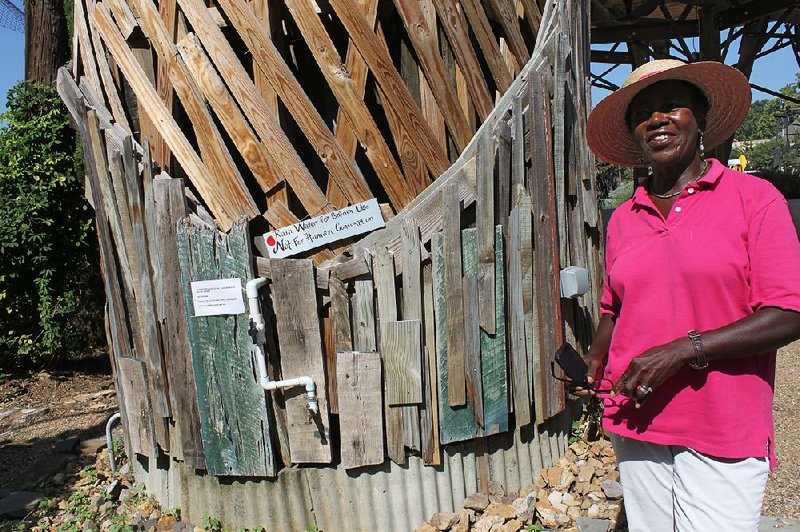The names come easy to Laverne Davis.
Evergreen wisteria. Confederate jasmine. Cosmos orange. Double purple datura. Russian sage.
All those plants, and more, grow at Bernice Gardens on Main Street in SoMa, the South Main Street neighborhood in Little Rock.
Make that downtown Little Rock. This is about as urban as it gets in Arkansas, but back to nature in at least one way - all those plants get rainwater. Not just from the sky, but from the 500-gallon plastic tank on site.
Why rainwater? What about all that nice water from Lake Maumelle? And if rainwater is good for plants, is it also good for people?
In a rain barrel: How come?
Davis is the gardener here, and a master gardener. She says the rainwater has two advantages. “It’s better than chlorinated water.” And it’s pretty much free.
In a previous life, the 6-foot tank was used at a car wash. The system is simple. Rain falls. It flows down a big plastic chute into the tank, fitted with a screen to keep out undesirable stuff. The roof of the tank is painted to block the sun and keep algae from growing.
Down below there’s a faucet. The water comes out via gravity, although Dale Allen, who fixes things at the garden, says a 110-voltpump is in there if needed.
Organic mosquito dunks (they look like doughnuts) are put into the tank to kill the larvae of the bloodsucking beasts.
All good. Just don’t drink it. In fact, Davis says, a sign - not for human consumption - was put up recently to warn the street people.
This is, after all, downtown.
It’s possible to use rainwater for drinking. More about that later. First, some background from Mike Daniels, a professor of water quality and nutrient management at the University of Arkansas Division of Agriculture in Little Rock.
We all drink rainwater, Daniels says, after we capture it - and treat it. “Lake Maumelle water is pristine, but I wouldn’t drink it.” Homeowners who use rainwater for anything other than watering plants should have a sufficient filtration system, he says.
Rainwater straight from the clouds is pure, Daniels says, but when it runs off a roof it collects all sorts of things - metal, bird droppings, ash. In some states other than Arkansas, it’s illegal to capture rainwater. “It’s considered a serious alteration of natural hydrology.”
Want to use rainwater? Collect some and get it tested, Daniels says, either by a private lab or the Division of Agriculture, to find out what bacteria or chemicals might be in it.
What does the Arkansas Department of Health have to say about rainwater for human consumption? Not much, says its spokesman Ed Barham. There are no department guidelines specific to rainwater harvesting. But he cautions against what comes off a roof, using the word “pathogens.”
In a way, Daniels says, water quality is relative.
“I’d be far more inclined to drink rainwater than lake or creek water. But more likely to drink deep groundwater than rainwater.”
“We’re seeing an upswing in people who want to capture water with rain barrels and use it for landscaping but not for drinking,” Daniels adds. “I tell people we’re returning to the things we used to do, capturing and using what nature gives us.”
That aptly describes Robin Mero Butler and her husband, Kevin, who live in a 1,000-square foot cabin in Boxley, in Newton County. It is, she says, “the coolest little cabin in the woods.”
Butler described how the couple use rainwater exclusively, including for drinking.
Their home has a metal roof designed, she says, “to capture every drop of rainwater.” The water flows into a 2,100-gallon cistern.
“It could fill a small swimming pool.”
She also has rain barrels around the house to collect water for the flowers.
The average American uses 100 gallons of water a day, Butler says, a fact confirmed by the U.S. Geological Survey. “That’s pretty wasteful to my mind.”
Not that the Butlers live in some primitive way. They have a clothes washer, a dishwasher, a bathtub, shower and toilet.
“We’re fairly normal. We like to be clean.”
Clean applies to the collected rainwater as well. It’s filtered from the roof through a screen. There’s another strainer at the pump. Plus an activated charcoal-spun fiber filter. Then the water comes out of the faucets.
“For drinking water I have a Berkey water filter on the counter top. But we bathe and wash with what comes out of the faucets.”
No one ever got sick drinking this water, Butler says. “There’s nothing to scare me into feeling it’s not safe.”
Using rainwater has advantages, both practical and psychic.
“I don’t pay to get the water and I don’t pay to send it back into the system,” Butler says. “It’s a very freeing feeling to use what God has sent to us in the way he intended.”
Style, Pages 29 on 10/15/2013

